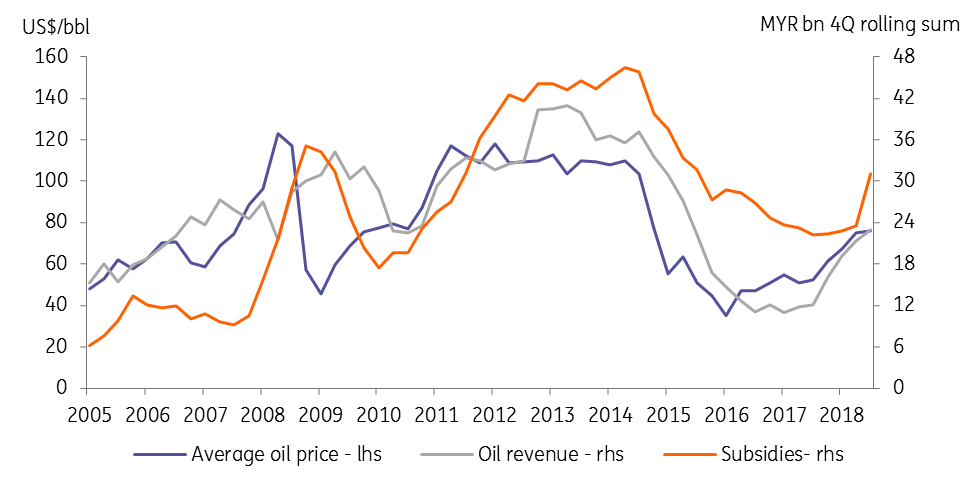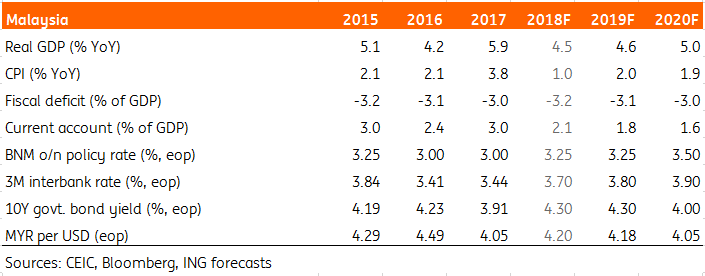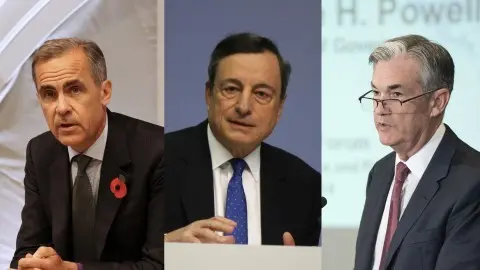Malaysia 2019 Budget Preview – A derailed fiscal consolidation
Sweeping policy changes under the Malaysian government’s drive to improve people's standard of living and drive out political corruption have strained public finances. We expect this to push the fiscal deficit above 3% and keep it there through 2019
Long-term inclusive growth, sustained development
The Mid-term Review of the 11th Malaysia Plan 2016-2020 (11MP) unveiled by Prime Minister Mahathir earlier this month (18 October) sets a clear tone for the upcoming Federal Budget for 2019 – a derailed fiscal consolidation. The first budget of the Pakatan Harapan [Alliance of Hope] coalition government will be presented to the parliament by Finance Minister Lim Guan Eng on Friday next week, 2 November.
As per the 11MP review, the fiscal policy by the new administration will be driven by objectives of an ‘inclusive growth and sustained development’. As tighter fiscal stance and risk from global trade tension slam the breaks on the economy, the government has downgraded GDP growth target for the remaining plan period, 2018-2020, by half a percentage point, from 5-6% in the original plan to 4.5-5.5%. The target for inflation is also revised slightly from 2.5-3% to 2-3%. And, contrary to the earlier target of a balanced budget by 2020, the fiscal deficit is now projected at 3% of GDP over the plan period.
Notwithstanding its drive to rein in high public debt the focus remains on continued fiscal consolidation. Yet the year 2018 will see the trend of steadily falling fiscal deficit underway since 2009 coming to an end; the deficit hit a record 6.7% of GDP in 2009 and has more than halved to 3% by 2007 (see below). The initial budget for 2018 under the previous administration had projected a further fall in the deficit to 2.8% this year. That's not going to materialise.
A decade-long fiscal consolidation coming to end - fiscal deficit (% of GDP)

Sweeping policy changes – elimination of GST and more
The economic policies took a significant turn, either for good or bad, after Dr Mahathir’s coalition took over the helm in May this year. Keeping with its election agenda of boosting people's standard of living and cleaning the corrupt political machinery, the new administration launched sweeping policy changes. The most prominent among these are elimination of Goods and Services Tax (GST), replacement of GST with SST (Sales and Services Tax), and suspension of mega investment projects undertaken by the previous government in collaboration with foreign governments (China, Singapore, etc.). These policies certainly will have an adverse bearing on the fiscal situation in the current year and beyond.
The Finance Minister, Lim Guan Eng, is on record as saying that it would be "foolish" for the current government, which took power in May, to abide by "unrealistic" fiscal targets set by the previous administration. The policy shift makes the target of limiting the deficit at 3% a challenging task for the government as heightened global economic risks – the trade war, geopolitics, and emerging market routs – will undermine Malaysia’s economic performance. As can be conjectured from the 11MP ditching of the balanced budget target, and holding a 3% line on the deficit over the remaining plan period, the fiscal deficit will have surged past the 3% mark in the current financial year itself and will likely prevail above that level in the medium-term.
Limiting the deficit at 3% will be challenging
A strong run for the economy in 2017, with close to 6% of GDP growth, and through the first quarter of this year and a boost to petroleum revenue from higher oil price might have supported total government revenue in the current year. Indeed, the 10% year-on-year revenue growth in the first half of 2018 compares with 0.8% growth in the same period last year. The growth of operating government spending also accelerated to 6% from 1.5% over the same period, though it was offset by slower development spending to -0.7% from 1.9%. This left the fiscal deficit at 4.5% of GDP in the first half of the year, not unusual for the period yet raising the risk of an overshoot in the full-year deficit.
However, the real hit to the budget will have started after the removal of the GST in June, while the overall economic performance also started to weaken from the second quarter of the year - a double whammy to government revenue. The launch of the SST in September will make up for some of the GST revenue loss, but not all.
On the spending side, PM Mahathir has assured steady operating expenditure in a drive to fulfil election promises. The suspension of public investment projects will have kept development expenditure well under MYR 46bn planned in the original budget, of which only less than half was incurred in the first half of the year. While the revenue loss from consumer tax reforms will far outweigh saving on development spending, weak investment will further compound GDP growth slowdown and pressure the deficit in relation to GDP higher.
With this backdrop, we anticipate fiscal deficit in the current year rising to 3.2% of GDP from 3.0% in 2017.
What’s in store from the 2019 Budget?
The forthcoming budget will set the course for the fiscal policy in the coming years. And, in all likelihood, it will be a tightening rather than easing. Here are some of the revenue and spending side factors deserving attention in the 2019 budget formulation:
- The tighter fiscal policy stance combined with sustained external risk suggests Malaysia’s GDP growth will remain under pressure in 2019, more likely staying close to the low end of 4.5-5.5% target.
- Slower GDP growth will be associated with a continued slowdown in government revenue in 2019, while the MYR 23bn revenue gap left consumer tax reforms – MYR 44bn loss from the elimination of the GST as against MYR 21bn revenue from SST – will need to be plugged. However, the loss to the government is gain to the people. And the increase in household disposable income will sustain private consumption as a strong driver of GDP growth in the next year.
- Just a few weeks ago PM Mahathir signalled introduction of new taxes as well as the sale of assets to boost the revenue and curb the debt. However, media reports suggest some of the widely talked new taxes -- capital gains and inheritance taxes, as well as an extension of SST net to online business (digital tax) – might not be part of the 2019 budget. Indeed, they will need a thorough public consultation before implementation.
- Higher oil price will be the key positive for the economy and the public finances. It will not only soften the impact of the global trade war on Malaysian exports but also will increase the petroleum revenue to the government (see below). But a high oil price also means higher government expenditure on fuel subsidies to the public. The reports of $70 per barrel oil price assumption for the 2019 Budget may be an understatement in view of the current level of about $80 per barrel, and the likelihood of geopolitics keeping it on the upward pressure in 2019.
- While the plan to significantly cut down on public debt, estimated over MYR 1 trillion (80% of GDP), over next two years faces headwinds from slower revenue growth, the cancellation costs of some of the infrastructure projects undertaken with other countries could blunt the debt reduction efforts. Moreover, the drive to cut down on development spending also bodes ill for the overall economic outlook.
Higher oil price raise government revenue but also lift spending on subsidies

Still, a healthy policy balance overall
We think the pressure to bring public finances back on track to consolidation without hampering economic prospects, especially in an environment of elevated external economics risks, will be a challenging task for policymakers in the near-term. We expect the budget deficit to remain elevated above 3% in coming years, with our forecast of 3.1% of GDP for 2019 and 3% for 2020.
Hopes are also pinned on higher oil prices
The downside risk to our deficit forecast stems from a significant reduction in development spending, though that also means a greater downside GDP growth risk. The hopes also are pinned on higher oil price providing positive terms of trade shock to Malaysia's net oil exporting economy, while the economy continues to be largely driven by domestic demand that will get further support from consumer-friendly tax reforms as well current low level of inflation. We maintain our 4.5% GDP growth forecast for this year and revise the forecast for the next year slightly downward to 4.6% from 4.8%.
We believe the lower inflation allows for some policy balance, by letting the central bank (Bank Negara Malaysia) to maintain an accommodative monetary policy stance as the government has now embarked on a fiscal tightening to rein in the large public debt burden. We expect inflation to average around 1% this year and to come in at the low end of the 2-3% official medium-term target in 2019.
The MYR has weakened to almost a year-low level against the USD of 4.18 on growing fiscal jitters ahead of the 2019 budget presentation next week. However, with sufficiently positive real interest rates the MYR should retain its year-to-date Asian outperformer position over the rest of the year. We consider our end-2018 USD/MYR forecast of 4.20 subject to upside risk, while we expect the pair to hover around that level through most of 2019.
Malaysia - Key economic forecasts

This publication has been prepared by ING solely for information purposes irrespective of a particular user's means, financial situation or investment objectives. The information does not constitute investment recommendation, and nor is it investment, legal or tax advice or an offer or solicitation to purchase or sell any financial instrument. Read more
Download
Download article
26 October 2018
Good MornING Asia - 29 October 2018 This bundle contains 5 Articles